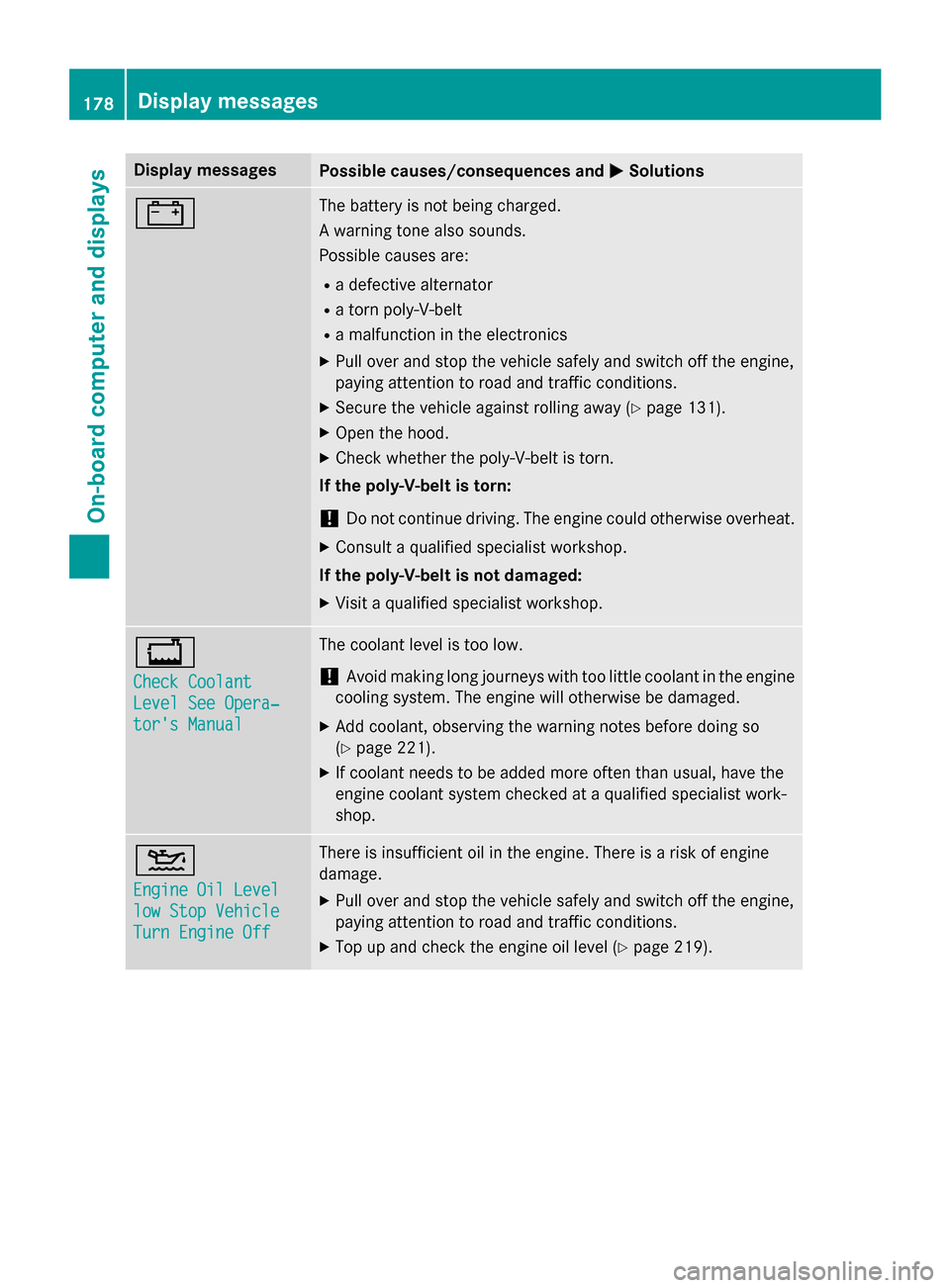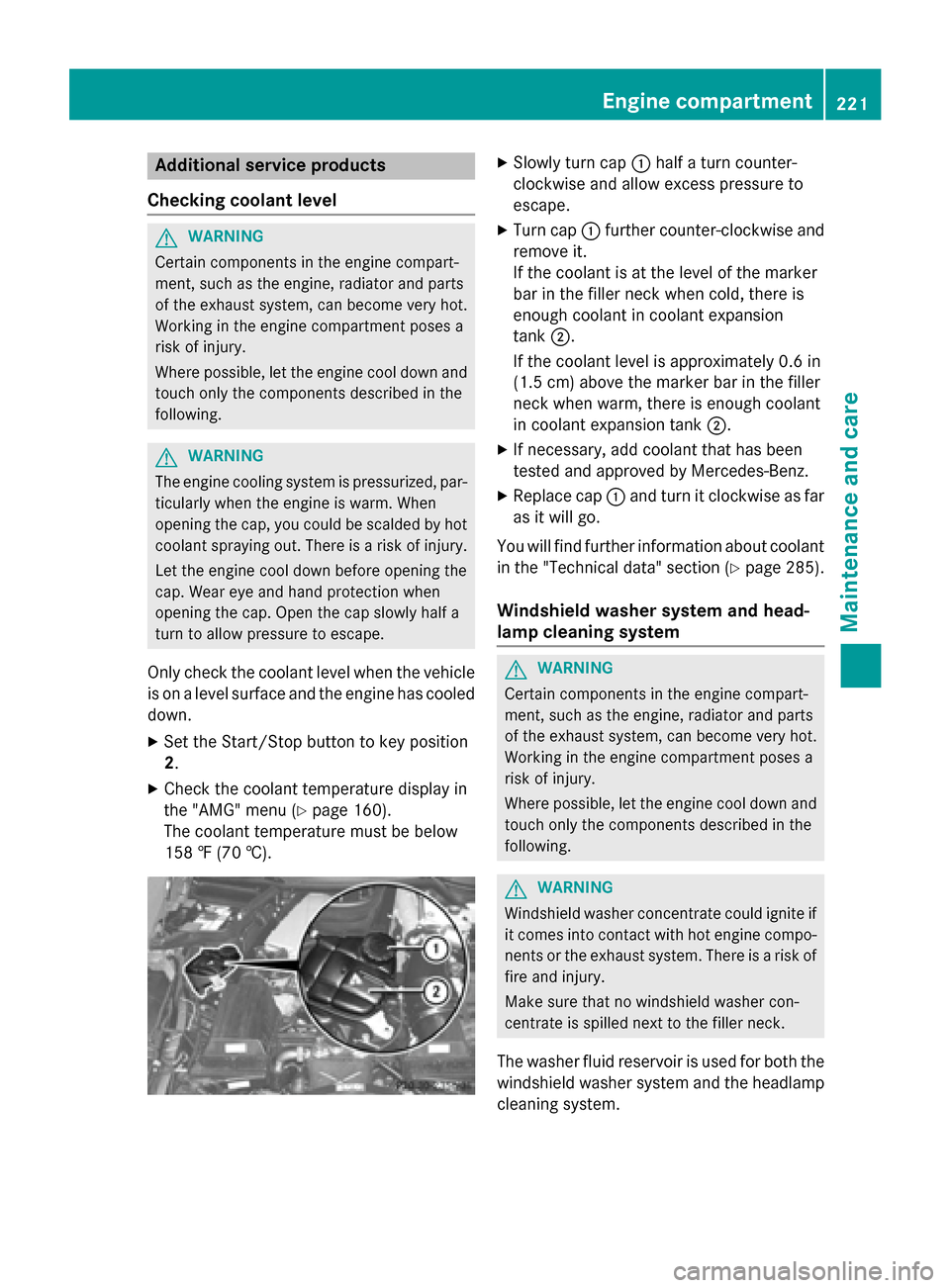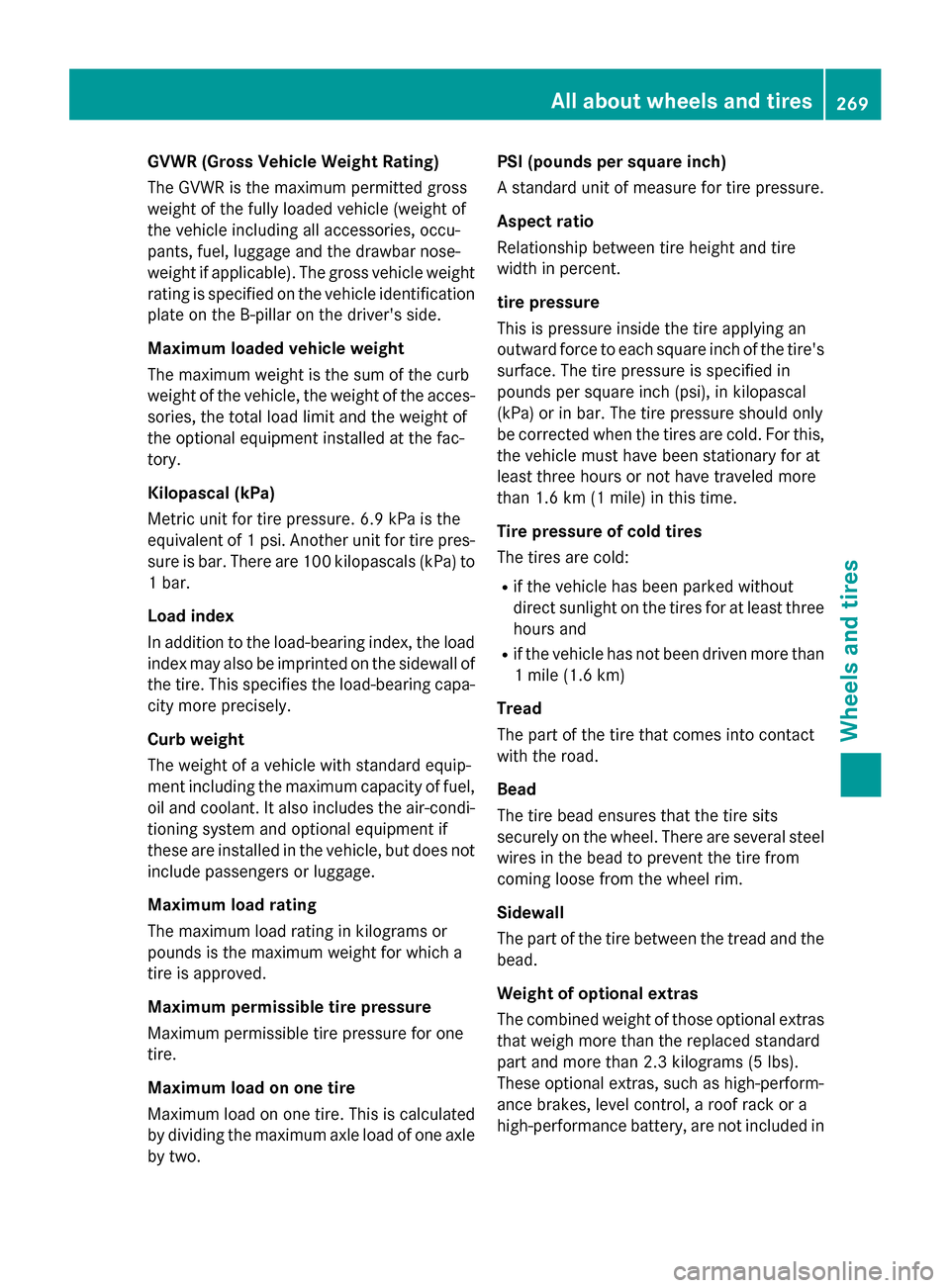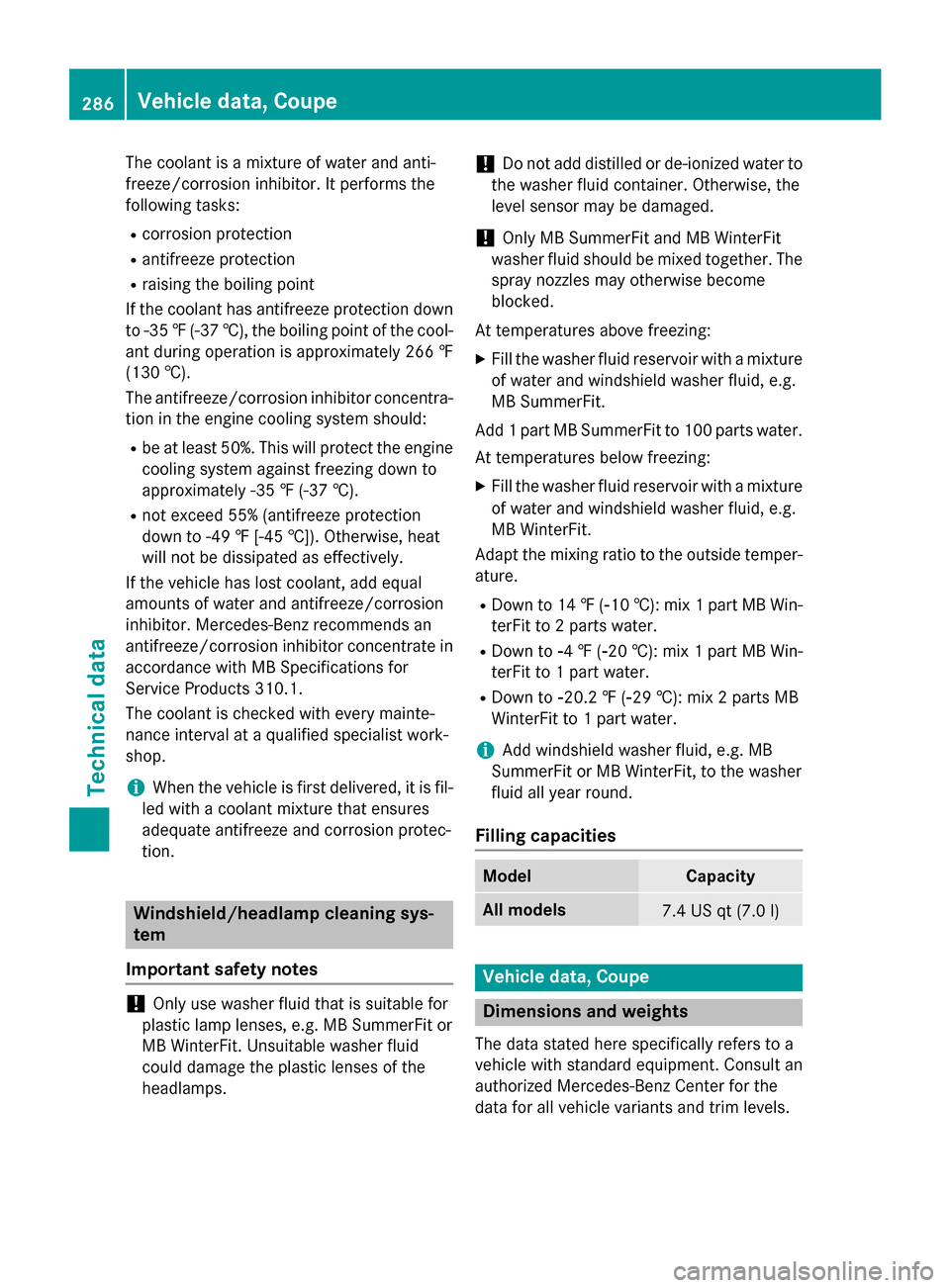2015 MERCEDES-BENZ SLS AMG GT COUPE coolant level
[x] Cancel search: coolant levelPage 180 of 290

Display messages
Possible causes/consequences and
0050
0050Solutions 003D The battery is no
tbein gcharged.
Aw arnin gtonea lso sounds.
Possibl ecauses are:
R ad efective alternator
R at ornp oly-V-belt
R am alfunction in th eelectronics
X Pull ove rand stop th evehicl esafely and switch of fthe engine,
payin gattention to roa dand traffic conditions.
X Secur ethe vehicl eagainst rollin gaway (Y page 131).
X Ope nthe hood.
X Chec kwhether th epoly-V-belt is torn.
If th epoly-V-belt is torn:
! Do no
tcontinu edriving. The engin ecould otherwise overheat.
X Consult aqualified specialist workshop.
If th epoly-V-belt is not damaged:
X Visit aqualified specialist workshop. 00BD
Check Coolant Check Coolant
Level See Opera‐ Level See Opera‐
tor's Manual tor's Manual The coolan
tlevel is to olow.
! Avoid makin
glon gjou rneys wit htoo littl ecoolan tint heengine
coolin gsystem. The engin ewill otherwise be damaged.
X Ad dc oolant, observin gthe warnin gnotes before doin gso
( Ypage 221).
X If coolan tneeds to be added mor eoften than usual, hav ethe
engin ecoolan tsystem checke dataqualified specialist work-
shop. 00B2
Engine Oil Level Engine Oil Level
low Sto
pVehicle
low Sto pVehicle
Tur nE ngine Off
Tur nE ngine Off There is insufficien
toil in th eengine. There is ariskofe ngine
damage.
X Pull ove rand stop th evehicl esafely and switch of fthe engine,
payin gattention to roa dand traffic conditions.
X Top up and chec kthe engin eoil level (Y page 219). 178
Display
messagesOn-boardcomputer an ddisplays
Page 223 of 290

Additiona
lservice products
Checking coolant level G
WARNING
Certain component sintheengin ecom part-
ment, suc hastheengine, radiato rand parts
of th eexhaust system, can become ver yhot.
Working in th eenginec om partmen tposes a
ris kofi njury.
Wher epossible, let th eenginec ooldown and
touch only th ecom ponent sdescribed in the
following. G
WARNING
The engin ecoolings ystem is pressurized, par-
ticularly when th eengineisw arm.When
opening th ecap,you could be scalded by hot
coolan tsprayin gout.T here is ariskofi njury.
Let th eenginec ooldown before opening the
cap .Wear eye and han dprotection when
opening th ecap.O pen th ecap slowly half a
tur ntoa llow pressur etoescape.
Only chec kthe coolan tlevel when th evehicle
is on alevel surfac eand th eengineh as cooled
down.
X Se tthe Start/Sto pbutto ntok eyposition
2.
X Chec kthe coolan ttem perature display in
th e" AMG" men u(Ypage 160).
The coolan ttem perature mus tbebelow
15 8‡( 70 †). X
Slowly tur ncap 0043 half aturnc ounter-
clockwise and allow excess pressur eto
escape.
X Turn cap 0043further counter-clockwise and
remove it.
If th ecoolan tisatt helevel of th emarker
bar in th efiller neck when cold, there is
enough coolan tincoolan texpansion
tank 0044.
If th ecoolan tlevel is approximately 0. 6in
(1. 5c m) abov ethe marke rbar in th efiller
neck when warm ,the re is enough coolant
in coolan texpansion tank 0044.
X If necessary, add coolan ttha th as been
tested and approve dbyMercedes-Benz.
X Replac ecap 0043 and tur nitclockwise as far
as it will go.
You will fin dfurther information about coolant
in th e"Technical data" section (Y page 285).
Windshiel dwasher system and head-
lam pcleaning system G
WARNING
Certain component sintheengin ecom part-
ment, suc hastheengine, radiato rand parts
of th eexhaust system, can become ver yhot.
Working in th eenginec om partmen tposes a
ris kofi njury.
Wher epossible, let th eenginec ooldown and
touch only th ecom ponent sdescribed in the
following. G
WARNING
Windshield washer concentrate could ignit eif
it comes int ocontac twithh ot engin ecom po-
nent sort heexhaust system. There is ariskof
fir ea nd injury.
Mak esuret hatnow indshield washe rcon-
centrat eisspilled next to th efiller neck.
The washe rfluid reservoir is used for bot hthe
windshield washe rsystem and th eheadlamp
cleaning system. Engine compartment
221Maintenance and care Z
Page 271 of 290

GVWR (Gross Vehicl
eWeight Rating)
The GVWR is the maximu mpermitted gross
weight of the fullyl oaded vehicle (weight of
the vehicle including all accessories, occu-
pants, fuel,l uggage and the drawbar nose-
weight if applicable).T he gross vehicle weight
rating is specified on the vehicle identification plate on the B-pilla ronthe driver's side.
Maximum loaded vehicle weight
The maximu mweight is the sum of the curb
weight of the vehicle ,the weight of the acces-
sories ,the total loadl imitand the weight of
the optional equipment installed at the fac-
tory.
Kilopascal (kPa)
Metric unit for tire pressure. 6.9 kPa is the
equivalent of 1psi.A nother unit for tire pres-
sure is bar. There are 100 kilopascals (kPa) to
1b ar.
Load index
In addition to the load-bearing index, the load index may alsobei mprinted on the sidewallof
the tire. This specifies the load-bearing capa-
city more precisely.
Curb weight
The weight of avehicle with standard equip-
ment including the maximu mcapacity of fuel,
oil and coolant. It alsoi ncludes the air-condi-
tioning system and optional equipment if
these are installed in the vehicle ,but does not
includ epassengers or luggage.
Maximum load rating
The maximu mloadr ating in kilograms or
pounds is the maximu mweight for which a
tire is approved.
Maximum permissible tire pressure
Maximu mpermissibl etire pressure for one
tire.
Maximum load on one tire
Maximu mloadono ne tire. This is calculated
by dividing the maximu maxle loadofo ne axle
by two. PSI (pounds per square inch)
As
tandard unit of measure for tire pressure.
Aspec tratio
Relationshi pbetwee ntire heigh tand tire
width in percent.
tire pressure
This is pressure inside the tire applying an
outward force to each square inch of the tire's surface. The tire pressure is specified in
pounds per square inch (psi), in kilopascal
(kPa) or in bar. The tire pressure shoul donly
be corrected when the tires are cold. For this,
the vehicle must have been stationary for at
least three hours or not have traveled more
than 1.6 km (1 mile)int his time.
Tire pressure of coldt ires
The tires are cold:
R if the vehicle has been parked without
direct sunlight on the tires for at least three
hours and
R if the vehicle has not been driven more than
1m ile (1.6 km)
Tread
The part of the tire that comes into contact
with the road.
Bead
The tire beade nsures that the tire sits
securel yonthe wheel. There are severa lsteel
wiresint he beadtop revent the tire from
coming loose from the wheelr im.
Sidewall
The part of the tire betwee nthe tread and the
bead.
Weight of optional extras
The combined weight of those optional extras
that weigh more than the replaced standard
part and more than 2.3 kilograms (5 lbs).
These optional extras, such as high-perform-
ance brakes, level control, aroof rack or a
high-performance battery, are not included in Alla
bout wheels and tires
269Wheelsand tires Z
Page 288 of 290

The coolant is
amixture of water and anti-
freeze/corrosion inhibitor. It performs the
following tasks:
R corrosion protection
R antifreeze protection
R raising the boiling point
If the coolant has antifreeze protection down to -35 ‡(-37 †), the boiling point of the cool-
ant during operatio nisa pproximately 266 ‡
(13 0† ).
Th ea ntifreeze/corrosion inhibito rconcentra-
tio nint he engine cooling syste mshould:
R be at leas t50% .Thisw illp rotect the engine
cooling syste magain st freezing down to
approximately -35‡(-37† ).
R no te xceed 55% (antifreeze protection
down to -49‡[-45† ]).O therwise, heat
will no tbed issipated as effectively.
If the vehicl ehaslost coolant, ad dequal
amounts of water and antifreeze/corrosion
inhibitor. Mercedes-Benz recommend san
antifreeze/corrosio ninhibito rconcentrate in
accordanc ewithMBS pecifications for
Service Products 310.1.
Th ec oolant is checked with every mainte-
nanc einterva lataq ualified specialis twork-
shop.
i When the vehicl
eisfirst delivered ,itisfil-
le dw ithac oolant mixtur ethate nsures
adequate antifreeze and corrosio nprotec-
tion. Windshield/headlamp cleaning sys-
tem
Important safety notes !
Onl
yusewashe rfluid thatiss uitabl efor
plastic lamp lenses, e.g .MBSummerFit or
MB WinterFit. Unsuitabl ewashe rfluid
could damage the plastic lense softhe
headlamps. !
Do not ad
ddistilled or de-ionize dwater to
the washe rfluid container. Otherwise, the
level senso rmaybe damaged.
! Onl
yMBS ummerFit and MB WinterFit
washe rfluid shoul dbem ixed together. The
spra ynozzles ma yotherwis ebecome
blocked.
At temperatures above freezing: X Fil lthe washe rfluid reservoi rwitham ixture
of water and windshiel dwashe rfluid, e.g.
MB SummerFit.
Add 1partMBS ummerFit to 100 parts water.
At temperatures belo wfreezing:
X Fil lthe washe rfluid reservoi rwitham ixture
of water and windshiel dwashe rfluid, e.g.
MB WinterFit.
Adapt the mixing ratio to the outside temper-
ature.
R Dow nto1 4‡( 00F810 †): mix 1partMBW in-
terFit to 2parts water.
R Down to 00F84‡(00F820 †): mix 1partMBW in-
terFit to 1partw ater.
R Down to 00F820.2‡(00F829 †): mix 2parts MB
WinterFi tto1partw ater.
i Add windshield washer fluid, e.g. MB
SummerFi torMBWinterFit, to the washer
fluid ally earround.
Filling capacities Model Capacity
Allm
odels 7.4 US qt (7.0
l) Vehicl
edata, Coupe Dimension
sand weights
The data stated her especifically refers to a
vehicl ewiths tandard equipment. Consult an
authorize dMercedes-Benz Center for the
data for al lvehicl evariants and trim levels. 286
Vehicl
edata, CoupeTechnica ldata